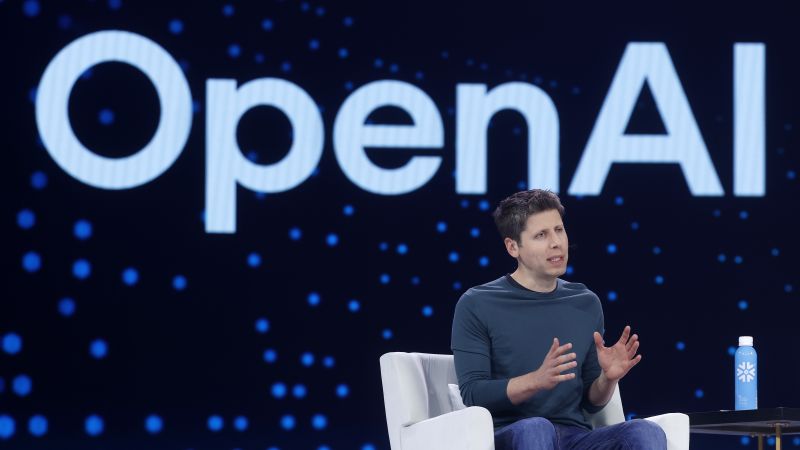[[{“value”:”
A version of this story appeared in CNN Business’ Nightcap newsletter. To get it in your inbox, sign up for free here.
New York
—
The rat’s nest of AI partnerships just got a bit more tangled. And for those who suspect the whole thing is a bubble, well, the latest entanglement is another thing to fret about.
ICYMI: OpenAI just struck a deal with AMD, a chip designer that directly competes with Nvidia, which itself announced a $100 billion investment in OpenAI less than a week ago. Nvidia, the world’s biggest company by market value, also competes with Oracle, which last month became the hot AI stock when it also reportedly struck a $300 billion deal with, you guessed it, OpenAI.
OpenAI, reportedly the biggest private company on the planet, with a half-trillion-dollar valuation, is also deeply financially connected to Microsoft and Google (the second- and fourth-most valuable publicly traded companies, respectively).
If it looks as if the industry is mostly a small handful of large companies sort of just trading money and services back and forth, congratulations: You understand the AI financing machine.
Under the deal announced Monday, which sent the chip designer’s shares (AMD) up 23%, AMD is effectively subsidizing demand by issuing OpenAI warrants for up to 160 million shares, investor Paul Kedrosky noted Monday. “That makes OpenAI a 10% shareholder: part customer, part financier — a risk transfer from cash to stock, as well as making OpenAI the largest and thus controlling AMD shareholder,” Kedrosky said.
As I wrote here last week, intertwined setups, including some known as “vendor financing,” are common in the frothy world of artificial intelligence. But the many layers of overlap, concentrated among the companies whose stocks have been propping up the US stock market, have made it hard to disentangle how much demand for AI is authentic hunger from customers and investors and how much of it is just capital being recycled to keep up the appearance of progress.
Vendor financing — along with the doubling, tripling or quadrupling of companies’ valuations — is one of the unflattering echoes some analysts see in comparing today’s AI frenzy with the late-90s dot-com bubble. Back then, telecom equipment giants like Cisco, Nortel and Lucent borrowed heavily to offer their customers financing deals that essentially ensured sustained demand for telecom equipment.
Because that high-tech equipment was in short supply, customers — many of them startups trying to build out fiber-optic cable — inflated their orders, contributing to a glut that left them reeling when, in 2001, it became clear the tech and telecom companies had overestimated demand. The equipment makers like Cisco were left holding bad debt while the startups went bust.
“We have all been witnessing elements of this behavior,” wrote Mike O’Rourke, chief market strategist at JonesTrading, in a note last month. “The lessons of the dot-com bubble are all but forgotten, but they echo in eternity,” he wrote, noting vendor financing was “key” to the demise of Lucent — once the world’s biggest telecom equipment company and billed, as Nvidia is now, as a “picks and shovels” play in the emerging tech economy. (Lucent barely averted bankruptcy in the 2002 downturn and was sold to French competitor Alcatel in 2006.)
No market two cycles are exactly alike, of course, and the existence of vendor financing is hardly a guarantee we’re in one now.
“We see some important differences,” Morgan Stanley analysts said in a note Monday. Chief among them: The Big Tech companies are in a much stronger financial position than many of the over-inflated stocks of the dot-com era.
But putting the discussion about circular financing and whether or not it’s profitable to the side, it’s worth looking at the product at the core of all this spending: generative AI powered by large language models, or LLMs. That’s where plenty of other investors, analysts and academics are screaming that the emperor has no clothes.
LLMs are popular, to be sure, and they’ve grown in capabilities in the past few years. Proponents say LLMs will change the world — someday. But their use cases have so far come up short of the “superintelligence” hype that AI advocates have long touted. An MIT survey of 300 companies found that 95% “are getting zero return” on their AI investment — a result that briefly rattled investors in August. Meanwhile, “workslop” — the nonsensical, unusable presentations spit out by AI — has become its own headache across many white-collar industries.
The downsides of AI are well-documented, however, as chatbots have dragged some people into delusional, at times deadly, spirals.
But let’s pick up that discussion of the dollars-and-cents business again. Because a bunch of people are starting to use the B-word.
“I think that this is the biggest and most dangerous bubble the world has ever seen,” Julien Garran of MacroStrategy Partnership wrote in a rather pessimistic report Friday. He estimates that a “misallocation of capital in the US” led by AI is 17 times bigger than the dot-com bubble and four times bigger than the 2008 real estate bubble.
Garran notes that the “majority of the LLM AI ecosystem” is losing money. “It is only an explosion in round-tripping” — buying and selling an asset over and over to create the appearance of high demand, distinct from vendor financing — “from Nvidia that is keeping the bubble inflated.”
“}]]

